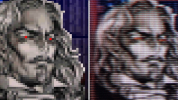Hi
Thinking about the best looking games to me on PS1 (fully 3D) and PS2 I realized that they are often at higher resolution or 60 fps, for example on PS1 it's the case for Tomb Raider III-V which are at 512x240 with fairly open areas (unlike Crash Bandicoot games or fighting games) and on PS2 many are 60 fps such as Onimusha 3, Shadow of Rome, and even Shadow of The Colossus (despite a less stable framerate).
I don't really understand these choices since it doesn't allow to have the best possible graphics in theory, maybe the higher resolution on PS1 was used to make the jaggies less obvious and they couldn't significantly push the hardware further even without increasing the resolution?, for 60 fps on PS2 this makes obviously more sense but what I understand less is why there is no or few 30 fps games that are as impressive as these 60 fps games, same for PS1 with fairly open games at 320x240, unless resolution and framerate are among the strengths of PS1 and PS2.
Sorry if these questions seem too basic for you guys but it seems weird to me, and for other consoles it appears to be less true (except maybe for Gamecube with the Star Wars games and Metroid Prime but the latest best looking games were rather 30 fps)
Thinking about the best looking games to me on PS1 (fully 3D) and PS2 I realized that they are often at higher resolution or 60 fps, for example on PS1 it's the case for Tomb Raider III-V which are at 512x240 with fairly open areas (unlike Crash Bandicoot games or fighting games) and on PS2 many are 60 fps such as Onimusha 3, Shadow of Rome, and even Shadow of The Colossus (despite a less stable framerate).
I don't really understand these choices since it doesn't allow to have the best possible graphics in theory, maybe the higher resolution on PS1 was used to make the jaggies less obvious and they couldn't significantly push the hardware further even without increasing the resolution?, for 60 fps on PS2 this makes obviously more sense but what I understand less is why there is no or few 30 fps games that are as impressive as these 60 fps games, same for PS1 with fairly open games at 320x240, unless resolution and framerate are among the strengths of PS1 and PS2.
Sorry if these questions seem too basic for you guys but it seems weird to me, and for other consoles it appears to be less true (except maybe for Gamecube with the Star Wars games and Metroid Prime but the latest best looking games were rather 30 fps)


